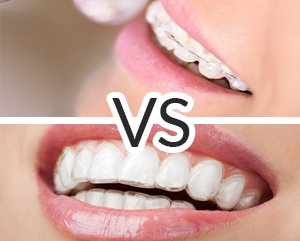When it comes to straightening teeth, there are several different options and different orthodontists tend to have different preferred methods. While, in the end, it is up to the dental patient to make the best decision for them, it’s impossible for an educated decision to be made without knowledge of what the differences are between the two. So let’s go over some of the key points where Invisalign and braces differ.
- Braces (even clear braces) can stain your teeth. The traditional bracket and wire makeup of braces can encourage tooth staining, even when clear braces are used. It’s not the brackets that stain teeth, but they can hold food and liquid against the tooth that can encourage staining. Things like coffee, tea, red wine and curry can all get caught around the brackets and wires and stain. This can be especially prevalent in dental patients who smoke. Invisalign generally protects the teeth from staining, unless you put the aligner on right after you eat or drink a food that stains without first at least rinsing.
- Invisalign is removable. Traditional braces cannot be removed and so that can make dental maintenance like brushing and flossing more difficult. For some patients, it even makes just eating harder. Invisalign being removable is certainly a way to make that easier. However, there is also a down side to it being removable. The aligners must be worn for at least 22 hours a day in order to be effective and its easy for a patient, especially younger patients, to give in to the temptation to leave the aligner out or to repeatedly remove it. This renders the aligners less than effective. You must remove aligners whenever you eat or drink, and so that can mean speeding through meals if you want to get your 22 hours of wearing time.
- Braces take fewer adjustments. Invisalign trays have to be adjusted and changed out every two weeks as opposed to every four to six weeks for traditional braces. This can mean they a lot more visits to your dentist and that may not work well for a patient who is busy or who has anxiety surrounding dental visits. Some orthodontists will be willing to work with patients and give them two or three trays per visit with instructions on how to use them and when to change them, but that cannot be guaranteed.
- Invisalign can be more gentle on soft tissue. Traditional braces are well known for causing initial irritation against the inside of the cheek, the lip and gums. While most people eventually adjust and do not have problems long term, the discomfort can be avoided for Invisalign users. The smooth aligning trays tend not to snag or wear against soft tissue.
- Braces can treat more severe issues. Invisalign can treat crowding, gaps and over or under bites like braces can, provided they are not severe cases. Braces, however, can also treat those issues as well as more severe cases and dental issues like cross bites, misalignments and malocclusions, and more.
As you can see, there are pros and cons to each method and it is important to know what the best option is for you and your needs.




